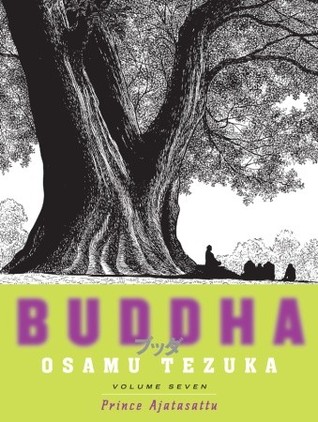Titles:
Buddha
-
Volume 6: Ananda
-
Volume 7: Prince Ajatasattu
-
Volume 8: Jetavana
Writer and Artist: Osamu Tezuka
I have reached the end of Tezuka's
Buddha series. My previous posts on this manga can be found
here,
here and
here. While I am not completely ignorant of Buddhist teachings, I don't know enough to say with any authority whether Tezuka portrays the faith or its central figure accurately. However, I can say the presentation is highly engaging and provides enough of an introduction to the subject matter to inspire a novice to learn more.
From comments on some of my posts about sequential art (the fancy-schmancy way of saying
comic books), I've gotten the sense that many are not entirely comfortable with the idea of serious subjects presented in this medium. To a point, this is understandable. In American society, at least, comics and cartoons are associated with children, humor and/or the fantasy realm of superheroes. A graphic novel about the sociopolitical dynamics of pre-war Germany, for instance, might not even seem possible, let alone appealing. But if one takes a step back, one might acknowledge that film and other visual arts deal adeptly with a broad range of material and there's really no reason comic books can't accomplish the same.
Of course, religion would be considered by many to require a higher level of serious treatment than most subjects. A certain reverence is expected for any faith. But the Japanese perspective on religion - particularly their own - is quite different from the typical Western view. Most modern Japanese don't consider themselves to be religious at all. However, religious rituals dominate the culture. As the saying goes, the Japanese are born Shinto and they die Buddhist. Most of the customs associated with birth come from Shintoism, the animistic faith native to Japan, while the customs surrounding death come from Buddhism. People take those rituals very seriously, indeed, but more for the rituals themselves than any deeper belief system. Religious satire isn't nearly as taboo as it is in Western society so even the occasional moments of levity within the
Buddha series are not entirely out of place within the broader context.
Osamu Tezuka (1928-89) is considered by many to be the greatest and most
influential of all manga creators. This was not my introduction to his
work. I was less impressed by the
Black Jack series. I feel
Buddha was a much stronger showcase of his talents, as both artist and storyteller.



Daughter has this whole series. She is a huge fan of Osamu Tezuka.
ReplyDeleteAnd I so agree about the graphic novels vs our belief that comic books are for children. As I sure you have seen by your time in Japan, there are graphic novels that cover a multitude of subjects. I have several on manners and what to do when visiting. It is just a who;e different mind set.
I am so enjoying your thoughts on this series.
cheers, parsnip
At the time, I myself thought the whole comic book culture was kind of silly. I was still stuck in the American mindset of trivializing the medium. It is only now, exploring manga in translation, that I realize the high quality material that's out there. There's junk, too, of course just as there is in any popular art form. We read plenty of garbage, too, after all.
DeleteLiking the look of this series, and the subject matter appeals. Sequential art is a new term: but much prettier than graphic novel. I am encouraged to go find!
ReplyDeleteThank you :-)
Like the word comic, the word graphic has other connotations which undermine the credibility of the medium. Graphic has unseemly implications. Sequential art is a more technical distinction but you're right, it sounds a bit nicer, too.
Delete